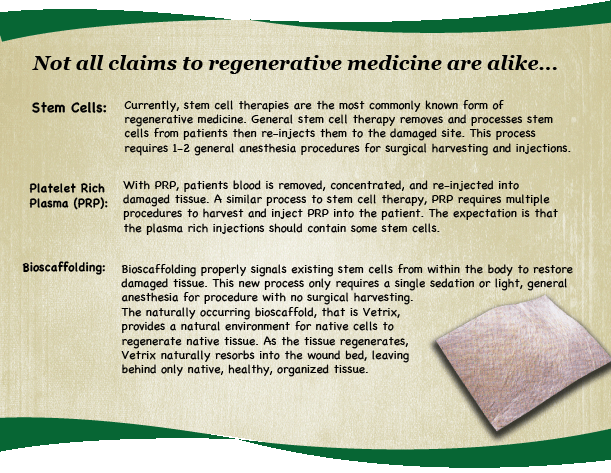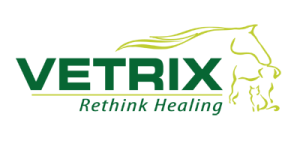Vetrix® BioSIS Frequently Asked Questions:
What is the main difference between Vetrix® BioSIS ECM and other collagen wound healing products on the market?
Vetrix® BioSIS is derived from a porcine source, and it has not been chemically stripped in its processing. This leaves the extracellular matrix (ECM) and other naturally occurring properties intact. It provides a natural environment for native cells to migrate across and grow new vascularized tissue. Many competitive products are treated harshly with chemicals or radiation. They lose the naturally occurring scaffold, retained in our product, on which cells grow.
Is it a dressing or a graft?
It is a naturally occurring extracellular matrix, or biologic graft. This product should not be referred to as a dressing.
What is the difference between the front and the back side of the material?
There is a smooth side or mucosal side, and a slightly rough side or serosal side. There is no clinical evidence that orientation plays a role in the migration of cells across or into the material.
Can it be used with cancer patients?
YES!
Is there any immune response?
No immunological response indicating rejection has been documented in any species. A mild inflammatory response may occur within the first few days which is typical during the normal healing process.
When should I apply Vetrix® BioSIS ECM?
Anytime after the injury, however it is recommended that Vetrix® not be applied until excessive exudate, bleeding, acute swelling and infection are controlled. Wounds should always be properly prepared for treatment. Vetrix® requires a blood supply to properly heal. If the wound has already begun to scar, debridement may be necessary to create vascularization to the wound.
How many applications are needed to repair skin wounds?
In many instances one application is sufficient; however, additional applications may be applied every 5-10 days until wound healing has occurred. Remember to keep the wound in a moist environment. There may be a caramel appearance in the wound bed during the healing process, but no further debridement should be performed. The graft should maintain intimate contact with the wound bed, so in some cases, suture may be necessary.
Be sure to take strong precautions when changing bandaging. Exudate may cause the bandage to stick to the matrix. Make sure not to disrupt the patch when changing bandage.
When placing Vetrix® on an external wound, is there possibility of a hematoma forming under the patch?
If there is a strong blood supply to the wound bed then it may be necessary to fenestrate the Vetrix® in several places. This will allow exudate to seep through the material while holding Vetrix® flush against the wound bed.
When should I use multi-layered Vetrix® instead of a single layer?
Situations that require mechanical strength or deep wounds can benefit from multiple layers.
Do I need to rehydrate Vetrix® before suturing it into place?
It has been shown that the material regains significant strength once rehydrated. Vetrix® BioSIS will hold sutures much better when it has been rehydrated.
Should I use water or normal saline to rehydrate the material?
Normal saline or isotonic solution should be used to rehydrate the material prior to use. Sterile water is acceptable in situations where sterile normal saline is not available.
How long does it take to rehydrate?
Single layer sheets will rehydrate in one minute while multi-layered sheets require several minutes longer. Cut the dry sheet to size prior to rehydration for ease of handling.
Should I use an antiseptic scrub on a dirty skin wound before applying Vetrix®?
Only sterile water or saline should be used. Saline spray alone is a less cytotoxic method of cleaning skin wounds being prepared for grafts.
Can I staple or suture it?
Either method can be used, but staples should be avoided in horses when possible due to granulation tissue embedding the staples. Sutures are preferred especially in vascular applications.


